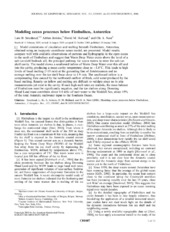Modeling ocean processes below Fimbulisen, Antarctica
Peer reviewed, Journal article
Permanent lenke
https://hdl.handle.net/1956/1061Utgivelsesdato
2006-01-18Metadata
Vis full innførselSamlinger
- Geophysical Institute [1198]
Originalversjon
https://doi.org/10.1029/2005jc002915Sammendrag
Model simulations of circulation and melting beneath Fimbulisen, Antarctica, obtained using an isopycnic coordinate ocean model, are presented. Model results compare well with available observations of currents and hydrography in the open ocean to the north of Fimbulisen and suggest that Warm Deep Water exists above the level of a sub-ice-shelf bedrock sill, the principal pathway for warm waters to enter the sub-iceshelf cavity. The model shows a southward inflow of Warm Deep Water over this sill and into the cavity, producing a mean cavity temperature close to -1.0ºC. This leads to high levels of basal melting (>10 m/a) at the grounding line of Jutulstraumen and an average melting over the ice shelf base close to 1.9 m/a. The southward inflow is a compensating flow caused by the northward outflow of fresh, cold water produced by the basal melting. Results on inflow and melting are difficult to validate since no in situ measurements yet exist in the cavity. If such high melt rates are realistic, the mass balance of Fimbulisen must be significantly negative, and the ice shelves along Dronning Maud Land must contribute about 4.4 mSv of melt water to the Weddell Sea, about 15% of the total Antarctic meltwater input to the Southern Ocean.
